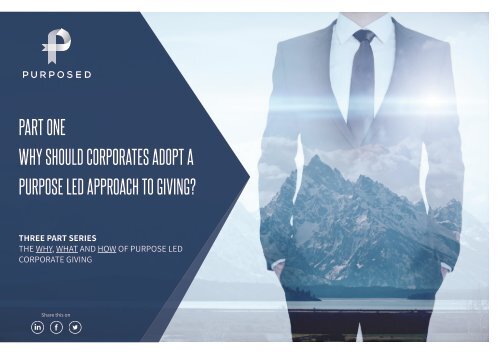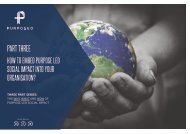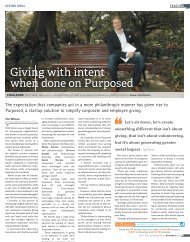WHY should corporates adopt a purpose led approach to giving?
The Why, What and How of Purpose Led Corporate Giving This is part 1 in a three part series distilling our research and what we’ve heard around three key questions 1. WHY should corporates adopt a purpose led approach to giving? 2. WHAT does best practice, purpose led corporate giving look like? 3. HOW can corporates embed social purpose within their organisations?
The Why, What and How of Purpose Led Corporate Giving
This is part 1 in a three part series distilling our research and what we’ve heard around three key questions
1. WHY
should corporates adopt a purpose led approach to giving?
2. WHAT
does best practice, purpose led corporate giving look like?
3. HOW
can corporates embed social purpose within their organisations?
- TAGS
- responsible-business
- skilled-volunteering
- triple-bottom-line
- more-and-better-giving
- csr
- social-impact
- community-investment
- social-responsibility
- corporate-volunteering
- corporate-philanthropy
- workplace-giving
- social-purpose
- purpose
- business-case
- volunteering
- donations
- philanthropy
- corporate-giving
- purposed
You also want an ePaper? Increase the reach of your titles
YUMPU automatically turns print PDFs into web optimized ePapers that Google loves.
PART ONE<br />
<strong>WHY</strong> SHOULD CORPORATES ADOPT A<br />
PURPOSE LED APPROACH TO GIVING?<br />
THREE PART SERIES<br />
THE <strong>WHY</strong>, WHAT AND HOW OF PURPOSE LED<br />
CORPORATE GIVING<br />
Share this on
THREE PART SERIES<br />
THE <strong>WHY</strong>, WHAT AND HOW OF PURPOSE LED<br />
CORPORATE GIVING<br />
To better understand how a <strong>purpose</strong> <strong>led</strong> <strong>approach</strong> can revolutionise the corporate <strong>giving</strong> landscape in Australia, this three part series distils<br />
research around three key questions:<br />
<strong>should</strong> <strong>corporates</strong> <strong>adopt</strong><br />
a <strong>purpose</strong> <strong>led</strong> <strong>approach</strong> <strong>to</strong><br />
does best practice,<br />
<strong>purpose</strong> <strong>led</strong> corporate<br />
<strong>WHY</strong> WHAT HOW<br />
<strong>giving</strong>?<br />
<strong>giving</strong> look like?<br />
<strong>to</strong> embed <strong>purpose</strong> <strong>led</strong><br />
corporate <strong>giving</strong> in<strong>to</strong> your<br />
organisation?<br />
Parts 2 and 3 will be released shortly, be first <strong>to</strong> get them by subscribing <strong>to</strong> our newsletter<br />
2
PART ONE<br />
<strong>WHY</strong> SHOULD CORPORATES ADOPT A PURPOSE LED APPROACH TO GIVING?<br />
WHAT’S INSIDE<br />
04 Why <strong>should</strong> <strong>corporates</strong> <strong>adopt</strong> a <strong>purpose</strong> <strong>led</strong><br />
<strong>approach</strong> <strong>to</strong> <strong>giving</strong>?<br />
07 Building a tangible business case<br />
– Cus<strong>to</strong>mer loyalty in a world of declining trust<br />
– Becoming an employer of choice<br />
– Solving the most pressing problems of our time<br />
14 The business case in practice<br />
16 Gaining leadership support<br />
3
<strong>WHY</strong> SHOULD CORPORATES ADOPT A<br />
PURPOSE LED APPROACH TO GIVING?<br />
Purpose <strong>led</strong> corporate <strong>giving</strong> is strategic investment that focuses <strong>giving</strong> <strong>to</strong> causes aligned with the <strong>purpose</strong> of your<br />
organisation, consumer market and employees<br />
Despite two decades of increasing philanthropic<br />
support for Not for Profits (NFPs), major social<br />
and environmental challenges remain<br />
pervasive in Australia and around the world.<br />
This experience indicates that NFPs alone do not<br />
have the capacity <strong>to</strong> effect systemic change; that<br />
Government alone does not have the capability <strong>to</strong><br />
address the root cause of many social issues; and<br />
that <strong>corporates</strong> alone do not have the ability <strong>to</strong><br />
tackle the issues plaguing <strong>to</strong>day’s society.<br />
To solve the most pressing problems of our time,<br />
Corporates, NFPs and Government with a<br />
shared sense of <strong>purpose</strong> must work <strong>to</strong>gether,<br />
be open <strong>to</strong> testing new solutions, and focus on<br />
generating both more and better <strong>giving</strong>.<br />
And when we refer <strong>to</strong> “<strong>giving</strong>”, its not just about<br />
<strong>giving</strong> funds, but also time, skills, experience,<br />
goods and services.<br />
The findings from the Giving Australia 1 research<br />
have been echoed in our conversations with<br />
Corporate Australia. Many of the Corporate Social<br />
Responsibility (CSR) Managers we speak <strong>to</strong> report<br />
that, despite exploring various technological<br />
and strategic solutions, they are still falling<br />
short of their employee <strong>giving</strong> and volunteering<br />
targets. Conversely, the employees we speak <strong>to</strong><br />
consistently report that they feel disconnected<br />
from the causes made available <strong>to</strong> them, or are<br />
unable <strong>to</strong> find the right avenue <strong>to</strong> meaningfully<br />
contribute in their already busy lives.<br />
4
This suggests that there is still a significant gap<br />
between the strategic, corporate <strong>led</strong> motivations<br />
for <strong>giving</strong> and the deeply personal, emotionally <strong>led</strong><br />
motivations of employees.<br />
In short, <strong>corporates</strong> are failing <strong>to</strong> effectively<br />
encourage the core driver for meaningful and<br />
sustained <strong>giving</strong>: the fulfilment of one’s social<br />
<strong>purpose</strong>. When it comes <strong>to</strong> creating impact and<br />
strengthening engagement, we must find better<br />
ways <strong>to</strong> help employees discover their <strong>purpose</strong>,<br />
and pursue it in ways that are easy, meaningful<br />
and impactful.<br />
While the above issues are not new, our recent<br />
engagements suggest that the corporate <strong>giving</strong><br />
landscape is on the cusp of a revolution. Leading<br />
<strong>corporates</strong> are being more strategic in their <strong>giving</strong>,<br />
and charities are exploring <strong>approach</strong>es <strong>to</strong> make<br />
<strong>giving</strong> more meaningful via virtual reality, and<br />
more transparent with the likes of blockchain.<br />
There is growing evidence <strong>to</strong> support the business<br />
case of <strong>adopt</strong>ing an authentic and engaging<br />
<strong>approach</strong> <strong>to</strong> <strong>giving</strong> that positions corporate and<br />
employee <strong>purpose</strong> at the heart.<br />
5
<strong>WHY</strong>? THE BENEFITS ARE CLEAR...<br />
PURPOSE<br />
PROMOTES<br />
CUSTOMER<br />
LOYALTY AND<br />
PROFITABILITY<br />
66%<br />
of consumers are<br />
willing <strong>to</strong> pay more for<br />
a socially responsible<br />
product or service 2<br />
90%<br />
of consumers report<br />
they would swap <strong>to</strong> a<br />
more ethical brand 3<br />
SHAREHOLDER<br />
VALUE<br />
Loyal & more<br />
profitable cus<strong>to</strong>mers<br />
+<br />
engaged employees<br />
=<br />
greater shareholder value<br />
44%<br />
of millennials would<br />
leave their current<br />
employer within the<br />
next two years <strong>to</strong> gain<br />
more meaning and<br />
fulfilment 4<br />
PURPOSE<br />
PROMOTES<br />
RETENTION &<br />
CREATES A THRIVING<br />
WORKPLACE<br />
CULTURE<br />
10X<br />
MARKET<br />
OUTPERFORMANCE<br />
Purpose <strong>led</strong> companies<br />
outperformed the S&P 500 by<br />
10 times between<br />
1996 and 2011 6<br />
$43K<br />
is the fully loaded cost<br />
of a single employee<br />
turnover 5<br />
$2,400<br />
of value is generated<br />
by every employee<br />
who participates in<br />
volunteering through<br />
their workplace 5<br />
6
BUILDING A TANGIBLE BUSINESS CASE<br />
Components of the business case<br />
The first, and potentially most significant barrier<br />
for <strong>corporates</strong> in <strong>adopt</strong>ing a <strong>purpose</strong> <strong>led</strong> <strong>approach</strong><br />
<strong>to</strong> <strong>giving</strong> is demonstrating a clear business case.<br />
Fortunately, the business case for social <strong>purpose</strong><br />
has been strengthened of late by readily available<br />
data on consumer behaviour and employee<br />
motivations.<br />
We have identified three clear and pervasive<br />
trends that support a <strong>purpose</strong> <strong>led</strong> <strong>approach</strong> <strong>to</strong><br />
deliver more and better corporate <strong>giving</strong>.<br />
This section explains each of these trends and<br />
provides the tangible and intangible benefits that<br />
will help you build your business case.<br />
What makes for a compelling<br />
business case?<br />
Firstly, consumers expect businesses <strong>to</strong> behave<br />
in a socially responsible way – their spending and<br />
loyalty increasingly reflects this.<br />
Secondly, employees now want more from their<br />
careers – attracting and retaining <strong>to</strong>p talent<br />
depends on more than compensation. Corporates<br />
must prioritise being an employer of choice.<br />
Thirdly, <strong>corporates</strong> are expected <strong>to</strong> play a key role<br />
in solving society’s most pressing problems – their<br />
employees want <strong>to</strong> be involved in contributing <strong>to</strong><br />
the solutions.<br />
Business case in practice - page 15<br />
7
BUILDING A TANGIBLE BUSINESS CASE<br />
1. Building cus<strong>to</strong>mer loyalty in a world of declining trust<br />
(Thankyou has) seen sales grow by 200%, outperforming cheaper products with no ethical pay-off<br />
The modern consumer expects businesses <strong>to</strong><br />
operate ethically, and believes that businesses<br />
have a responsibility <strong>to</strong> contribute <strong>to</strong> solving<br />
societal and environmental challenges. This<br />
belief guides consumer behaviour, with 90%<br />
reporting they would swap <strong>to</strong> a more ethical brand<br />
given a comparable offering 3 , and 66% willing <strong>to</strong><br />
pay more for a socially responsible product or<br />
service 2 .<br />
In 2014 Thankyou hand wash was the most<br />
expensive product of its kind s<strong>to</strong>cked in Australian<br />
supermarkets. Despite warnings that Thankyou<br />
was at risk of pricing itself out of the market, they<br />
remained steadfast that discerning consumers<br />
would be willing <strong>to</strong> pay more for an ethical<br />
product contributing <strong>to</strong> social good. Since getting<br />
Thankyou products in<strong>to</strong> supermarkets, they have<br />
seen sales grow by 200%, outperforming cheaper<br />
products with no ethical pay-off 7 .<br />
Further <strong>to</strong> this, retailers here in Australia and<br />
abroad have been building cus<strong>to</strong>mer loyalty (while<br />
boosting sales) by providing consumers with<br />
opportunities <strong>to</strong> recycle goods at their s<strong>to</strong>res.<br />
Bunnings warehouse for example offers e-waste<br />
drop off events <strong>to</strong> ethicaly dispose of the materials<br />
on your behalf, <strong>giving</strong> people another excuse <strong>to</strong><br />
wander the aisles over the weekend.<br />
By contrast, Volkswagen’s sales plummeted by<br />
20% in the wake of its diesel emissions scandal,<br />
and the company recorded its first annual loss<br />
in 20 years 9 . The VW example is a stark reminder<br />
that people have the power and their collective<br />
action (or inaction) can hit a company where it<br />
hurts – their share price.<br />
These examples demonstrate the power of the<br />
consumer and how willingness <strong>to</strong> pay can be<br />
heightened when the consumer connects with the<br />
<strong>purpose</strong> behind a product.<br />
8
Trust is a valuable commodity that cannot be<br />
bought, and once lost is hard <strong>to</strong> res<strong>to</strong>re. 92%<br />
of consumers trust peer reviews over advertising,<br />
proving that businesses need <strong>to</strong> embed deep<br />
levels of trust in their employees, clients, and<br />
shareholders 9 . The average consumer is worth<br />
10 times the amount of their first purchase, but<br />
it takes 12 positive interactions <strong>to</strong> counteract<br />
every negative one 10 . Employees are at the<br />
coalface of building trust for your business. In<br />
fact, millennial employees feel that where they<br />
can have the greatest amount of influence is on<br />
cus<strong>to</strong>mers, suppliers, and their peers. They see<br />
that their influence can be exerted through small<br />
scale, immediate actions, that ultimately influence<br />
the bigger picture.<br />
Why <strong>should</strong> you care?<br />
CUSTOMER LOYALTY IS A THING OF THE PAST<br />
90%<br />
90% of consumers report they would swap<br />
<strong>to</strong> a more ethical brand for a comparable<br />
offering 3<br />
CUSTOMERS PAY A PREMIUM FOR PURPOSE<br />
66%<br />
66% of consumers are willing <strong>to</strong> pay more for<br />
a socially responsible product or service 2<br />
This brings us <strong>to</strong> one of the fundamental reasons<br />
for investing in a corporate <strong>giving</strong> program:<br />
employee engagement.<br />
9
BUILDING A TANGIBLE BUSINESS CASE<br />
2. Becoming an employer of choice<br />
‘Presenteeism’ costs the Australian economy $34 billion anually through lost productivity<br />
Only 13% of employees are engaged at work 11 ,<br />
and ‘presenteeism’ costs the Australian economy<br />
$34 billion annually through lost productivity 12 .<br />
An effective way <strong>to</strong> counteract the costs of lost<br />
productivity is by helping employees discover<br />
and pursue their social <strong>purpose</strong>. A recent study<br />
concluded that companies with strong community<br />
involvement see increases in employee<br />
productivity by as much as 13%, and reductions<br />
in turnover by as much as 50% 13 . A further study<br />
found that employees who volunteered, “worked<br />
harder, were more willing <strong>to</strong> help their colleagues,<br />
talked positively about their companies, and were<br />
less likely <strong>to</strong> waste time at work” 14 .<br />
Fostering employee engagement is one of the<br />
key drivers of contemporary corporate <strong>giving</strong><br />
programs, and for good reason.<br />
Our relationship with work has changed drastically<br />
over the past decade due <strong>to</strong> globalisation and<br />
au<strong>to</strong>mation. Increased digital connectivity has<br />
heightened the value of face-<strong>to</strong>-face volunteering<br />
opportunities that allow people <strong>to</strong> find a sense<br />
of belonging and community. If <strong>corporates</strong><br />
want <strong>to</strong> attract and retain <strong>to</strong>p talent, their value<br />
proposition needs <strong>to</strong> be more than just money,<br />
and must include opportunities <strong>to</strong> find a sense<br />
of meaning and personal connection within the<br />
workplace.<br />
Why is this important? Because Millennials will<br />
make up 75% of the workforce by 2025, and are a<br />
generation that prioritise social <strong>purpose</strong> in their<br />
personal and professional lives 15 . So much so that<br />
44% of millennials state that they would leave<br />
their current employer within the next two years<br />
<strong>to</strong> gain more meaning and fulfilment 4 .<br />
10
If this statement alone isn’t alarming enough, let’s<br />
look at the numbers.<br />
Research has found that the average fully loaded<br />
cost of employee turnover, including vacancy,<br />
recruitment and onboarding costs, is $43,000<br />
5<br />
. Yet, for every employee who participates in<br />
volunteering through their workplace $2,400 of<br />
value is generated through increased productivity,<br />
greater discretionary effort and fewer sick days 5 .<br />
To position yourself as an employer of choice<br />
you need <strong>to</strong> have a strong social <strong>purpose</strong> at the<br />
heart of your business, and must empower each<br />
individual employee <strong>to</strong> understand the unique<br />
role they can play in making a difference.<br />
Why <strong>should</strong> you care?<br />
MILLENNIALS ARE LEAVING FOR MEANING AVG. COST OF TURNOVER<br />
VOLUNTEERING PROVIDES MEANING AND<br />
GENERATES PRODUCTIVITY<br />
44%<br />
$43,000 $2,400<br />
of millennials would leave their current<br />
employer within the next two years <strong>to</strong> gain<br />
more meaning and fulfilment 4<br />
Fully loaded cost of employee turnover<br />
is $43,000 5<br />
Every employee who volunteers through<br />
their workplace generates an additional<br />
$2,400 of of organisational value 5<br />
11
BUILDING A TANGIBLE BUSINESS CASE<br />
3. Solving the most pressing problems of our time<br />
“The Dollar” is the universal language that<br />
solving the problems we’re emotionally connected<br />
their video received over two million views, along<br />
resonates with the executive, however putting a<br />
<strong>to</strong>. From a workforce engagement perspective it is<br />
with many comments that demonstrate their<br />
dollar figure on solving some of the most pressing<br />
important <strong>to</strong> give employees targeted choice <strong>to</strong><br />
consumer loyalty and recognition as an employer<br />
problems of our time can be extremely difficult.<br />
support the causes closest <strong>to</strong> their heart.<br />
of choice.<br />
With many concerned about the longevity of<br />
However <strong>to</strong> achieve large scale impact,<br />
Just like Air New Zealand, Larry Fink, head of<br />
Australia’s Great Barrier Reef, a 2017 Deloitte<br />
Corporates have the unique opportunity<br />
BlackRock <strong>to</strong>ld chief executives <strong>to</strong> “understand the<br />
study aimed <strong>to</strong> put a value on it by assessing<br />
<strong>to</strong> focus on a flagship cause of strategic<br />
societal impact of your business”, otherwise they<br />
the economic, social and icon asset value of this<br />
significance. The most impactful <strong>corporates</strong> are<br />
would lose society’s support and their “liecense <strong>to</strong><br />
natural wonder. They calculated that it supports<br />
those who have identified problems that are big<br />
operate” 17 .<br />
64,000 jobs and contributes $6.4 billion <strong>to</strong> the<br />
Australian economy, and along with its cultural<br />
significance could be valued at $56 billion 16 .<br />
in scale, neglected, and relevant <strong>to</strong> their industry,<br />
offering or organisational capability.<br />
Take Air New Zealand for example. They have<br />
With this in mind, leading <strong>corporates</strong> are aligning<br />
themselves with the United Nations Sustainable<br />
Development Goals, and are coming <strong>to</strong>gether <strong>to</strong><br />
While an interesting statistic, long before this<br />
made a commitment <strong>to</strong> tackle global climate<br />
form partnerships with other organisations and<br />
study had been conceived many had dedicated<br />
change with a long standing partnership with the<br />
NFPs <strong>to</strong> help address the world’s most pressing<br />
efforts <strong>to</strong> address the health of the reef.<br />
New Zealand Antarctic Research Institute. Not only<br />
problems. In many cases these partnerships will<br />
12<br />
The underlying reason we all rally around<br />
causes of social and environmental significance<br />
is because we all want <strong>to</strong> make a difference in<br />
do the provide monetary support, they are raising<br />
awareness during one of the dullest parts of their<br />
cus<strong>to</strong>mer’s experience – the safety demonstration<br />
(see following YouTube video). In just a few days<br />
strengthen individual business cases, but when<br />
asked why they are doing this, leaders respond<br />
“put simply, it’s the right thing <strong>to</strong> do” 18 .
Why <strong>should</strong> you care?<br />
EFFECTIVE PARTNERSHIPS WILL<br />
HELP SOLVE THE MOST PRESSING<br />
PROBLEMS OF OUR TIME<br />
13
THE BUSINESS CASE IN PRACTICE<br />
Loyal and more profitable cus<strong>to</strong>mers + engaged employees = greater shareholder value<br />
Now that you have research backed business case<br />
drivers, let’s use a hypothetical example <strong>to</strong> bring<br />
this business case <strong>to</strong> life.<br />
Here we compare two similar paper<br />
manufacturing businesses, Paper for Profit and<br />
Paper for Purpose.<br />
Paper for Profit has been around for 25 years and<br />
traditionally monopolised the paper manufacturing<br />
industry in the region. Five years ago a new<br />
competi<strong>to</strong>r Paper for Purpose emerged, offering<br />
the same product but in an environmentally<br />
responsible manner, and has managed <strong>to</strong> attract a<br />
number of cus<strong>to</strong>mers as a result.<br />
Both organisations now have the same number<br />
of cus<strong>to</strong>mers and employees, however Paper for<br />
Profit focusses purely on maximising short term<br />
profits. Paper for Purpose on the other hand, has<br />
a social <strong>purpose</strong> embedded in<strong>to</strong> its organisation’s<br />
DNA - <strong>to</strong> regenerate more forest than their paper<br />
manufacturing consumes. They want <strong>to</strong> leave the<br />
planet in a better place than when they started.<br />
Paper for Purpose make their intent extremely<br />
clear in all marketing efforts, and in turn, have<br />
attracted an extremely loyal cus<strong>to</strong>mer base who<br />
understand that a responsible product often<br />
comes at a price. Regardless, their consumers are<br />
happy <strong>to</strong> pay more for their product as it serves<br />
their social conscience.<br />
Recognised for its efforts, Paper for Purpose<br />
quickly became the region’s employer of choice,<br />
with people lining up <strong>to</strong> work for them. They<br />
attract and retain the best talent on offer, those<br />
who are more productive, creative and ethical<br />
- who also put in higher levels of discretionary<br />
effort. The passion their workforce has for<br />
their company brand and the work they do is<br />
impressive, especially given their product, paper,<br />
isn’t the most innovative on the market. As a<br />
result, Paper for Purpose realises less employee<br />
turnover, lower employee onboarding costs and<br />
higher rates of know<strong>led</strong>ge retention than its<br />
competi<strong>to</strong>r.<br />
Have a look at the following table <strong>to</strong> see how<br />
the two organisations compare from a revenue,<br />
organisational efficiency and social outcome<br />
perspective.<br />
14
Financial Outcomes<br />
Social Outcomes<br />
Paper for Purpose planted the equivalent of<br />
$10M<br />
Paper for Purpose generates $10M more<br />
shareholder value than its non socially minded<br />
competi<strong>to</strong>r, realising a 235% ROI on their Social<br />
Investment<br />
337k Trees<br />
674 international rugby fields of trees last<br />
year, delivering on their <strong>purpose</strong> <strong>to</strong> regenerate<br />
more forest than their paper manufacturing<br />
consumes<br />
Paper for Profit<br />
Paper for Purpose<br />
Has Social Investment Program No Yes<br />
Social Investment<br />
Corporate donations $0 $3,010,000<br />
Employee donations $0 $180,000<br />
Corporate matching employee donations $0 $180,000<br />
Volunteering (days) 0 1,500<br />
Volunteer value (time away from office) $0 $625,000<br />
Goods & services value N/A N/A<br />
Cost <strong>to</strong> manage program (FTE, Tech etc) $0 $450,000<br />
TOTAL Social Investment $0 $4,265,000<br />
Organisation Return<br />
CUSTOMER LOYALTY<br />
Number of cus<strong>to</strong>mers 80,000 80,000<br />
Cus<strong>to</strong>mer churn rate (pa) 10% 5%<br />
Cus<strong>to</strong>mer acquisition savings $0 $4,252,000<br />
EMPLOYER OF CHOICE<br />
Number of employees 5,000 5,000<br />
Volunteering participation rate 0% 30%<br />
Employee turnover (pa) 12% 9%<br />
Employee turnover savings $0 $6,450,000<br />
Employee productivity savings $0 $3,600,000<br />
TOTAL Organisation Return $0 $14,302,000<br />
Paper for Profit<br />
Paper for Purpose<br />
Has Social Investment Program No Yes<br />
Social Outcome Assumptions<br />
Cost <strong>to</strong> plant (fully loaded per tree) 0 $10<br />
Trees per Hectare 0 500<br />
CO 2<br />
<strong>to</strong>nnes captured p/Ha tree lifetime 50 yr $0 $14,300,000<br />
Social Outcomes<br />
Trees planted 0 337,000<br />
Football fields of reforestation 0 674<br />
Captured Carbon (<strong>to</strong>nnes) 0 67,400<br />
This hypothetical examples assumes the following<br />
- Employee volunteering efforts are focussed on planting trees<br />
- Does not include the social value generated from the donation of goods and services<br />
- Does not fac<strong>to</strong>r in any assumptions around the price premium which could be applied for ethical products<br />
- Organisational revenue $1,700M - Corporate donations pa 1% of profit<br />
- Organisational profit 319M - Employee donation participation 12%<br />
- Cus<strong>to</strong>mer acqusition cost $1,063 - Avg employee donation $300<br />
- New employee onboarding costs $43,000 - Avg volunteer commitment 1 day<br />
- Volunteer productivity savings $2,400 - Avg employee wage pa $100k<br />
ROI<br />
Profitability Uplift $0 3%<br />
Improved Shareholder Value $0 $10,037,000<br />
Return on Investment N/A 235%<br />
IMPORTANT<br />
As with any business case, never over promise <strong>to</strong> under deliver - your reputation is at stake! While the turnover costs and productivity gains used in this model are based on solid research, if the benefits look unrealistic, dial them back.<br />
Every organisation is different so If you don’t feel these drivers or assumptions reflect your organisation’s situation, work with your HR and Finance leaders <strong>to</strong> determine figures relevant for your company. It will give you the valuable opportunity <strong>to</strong><br />
engage them early, <strong>to</strong> get their input and support for your business case. Gaining the necessary cross functional support for an initiative like this is a crucial ingredient for success.<br />
15
GAINING LEADERSHIP SUPPORT<br />
Establishing a meaningful connection with consumers and your workforce provides the competitive edge <strong>to</strong><br />
improve profitability and transform your organisational culture.<br />
We now know that being a responsible<br />
organisation that gives back makes good business<br />
sense, and that brand protection and market<br />
share depend on the extra mile a business is<br />
willing <strong>to</strong> go <strong>to</strong> for the benefit of its stakeholders.<br />
So how can an organisation like yours get<br />
leadership support for a <strong>purpose</strong> <strong>led</strong> corporate<br />
<strong>giving</strong> program? There’s no doubt that the<br />
numbers are important. The first two business<br />
case fac<strong>to</strong>rs around cus<strong>to</strong>mer loyalty and<br />
employee engagement speak <strong>to</strong> the rational<br />
part of our brain: the dollarised proof that<br />
demonstrates the benefits generated through<br />
<strong>purpose</strong> <strong>led</strong> change.<br />
And this has been proven. A study on S&P500<br />
companies demonstrated that <strong>purpose</strong> <strong>led</strong><br />
companies outperformed the market by a fac<strong>to</strong>r<br />
of 10x between 1996 and 2011 6 .<br />
The third fac<strong>to</strong>r of the business case speaks <strong>to</strong> the<br />
emotional part of our brain: put simply, it’s the<br />
right thing <strong>to</strong> do. People think rationally and<br />
make decisions emotionally.<br />
By understanding the underlying motivations<br />
of your leadership and stakeholders, you can<br />
support your rational fact base with a crafted s<strong>to</strong>ry<br />
that engages their emotional side. We suggest you<br />
step in <strong>to</strong> the shoes of your leaders <strong>to</strong> understand<br />
what their motiva<strong>to</strong>rs are. Every individual is<br />
different, but <strong>to</strong> get you started here are some<br />
of the common motiva<strong>to</strong>rs for leadership within<br />
large organisations.<br />
16
GAINING LEADERSHIP SUPPORT<br />
Craft your message around what your leaders care about<br />
CFO<br />
Head of CSR/Foundation<br />
CEO<br />
Head of HR<br />
Employees<br />
What interests your CFO<br />
What interests your Head<br />
What interests your CEO<br />
Staying one step ahead<br />
<strong>to</strong> lead the company in<strong>to</strong><br />
the future and maximise<br />
shareholder value<br />
Increasing shareholder return<br />
by improving cus<strong>to</strong>mer<br />
profitability and operational<br />
efficiencies while reducing<br />
reputational risk<br />
What interests your<br />
Head of HR<br />
Being recognised as an<br />
employer of choice <strong>to</strong> attract,<br />
motivate and retain high<br />
calibre talent<br />
of CSR/Foundation<br />
Defining and embedding<br />
a community investment<br />
program that generates<br />
unprecedented social,<br />
environmental and corporate<br />
value<br />
What interests your<br />
employees<br />
Undertaking meaningful work that<br />
provides learning opportunities<br />
and exposure for career<br />
advancement<br />
Now you have the <strong>to</strong>ols <strong>to</strong> construct your own business case, get started on making <strong>purpose</strong> <strong>led</strong> corporate <strong>giving</strong> a priority on your leadership’s<br />
agenda. In the meantime we’ll be pulling <strong>to</strong>gether Part 2 of the paper: WHAT best practice, <strong>purpose</strong> <strong>led</strong> corporate <strong>giving</strong> looks like.<br />
Stay tuned and sign up for our newsletter <strong>to</strong> get it delivered <strong>to</strong> your inbox.<br />
17
REFERENCES<br />
1.<br />
Giving Australia 2016 Research<br />
2.<br />
Nielsen (2015) The Sustainability Imperative<br />
3.<br />
CONE (2015) Cone Communications/Ebiquity Global CSR Study<br />
4.<br />
Deloitte (2016) The 2016 Deloitte Millennial Survey<br />
5.<br />
CECP Corporate Leadership Council (2015) Giving in Numbers<br />
6.<br />
EY (2016) PURPOSE: Can a <strong>purpose</strong>, beyond profit, really drive results and<br />
long-term value?<br />
7.<br />
Fitzsimmons, C. (2014) How Thankyou Group cracked the hand wash<br />
market with the most expensive product in the supermarket<br />
8.<br />
BBC News (2016) VW profit tumbles 20% in wake of emissions scandal<br />
9.<br />
Nielsen (2017) Global Trust in Advertising<br />
10.<br />
Newell-Legner, R. (2008) Leader’s Guide: Secrets <strong>to</strong> Keeping Our Cus<strong>to</strong>mers<br />
Happy<br />
11.<br />
Harter, J. and Mann, A. (2016) The World Employee Engagement Crisis<br />
12.<br />
The Centre for International Economics (2016) The economic value of<br />
pathology: achieving better health, and a better use of health resources<br />
13.<br />
Babson College and IO Sustainability (2015) Project ROI: Defining the<br />
Competitive and Financial Advantages of Corporate Responsibility and<br />
Sustainability<br />
14.<br />
Rodell, J. (2013) Finding meaning through volunteering: why do employees<br />
volunteer and what does it mean for their jobs?<br />
15.<br />
World Economic Forum - 3 ways millennials are changing the world of work<br />
16.<br />
Deloitte (2017) Deloitte Access Economics: At what price? The economic,<br />
social and icon value of the Great Barrier Reef<br />
17.<br />
Financial Times 2018 - The shareholder-first corporate model erodes public<br />
support<br />
18.<br />
Purposed Corporate Social Impact Challenge 2018 - corporate attendee<br />
survey<br />
ACKNOWLEDGEMENTS<br />
Purposed acknow<strong>led</strong>ges the work of Sarah Wilson, Chris Cousins, Katherine Jude, Tom Ferrier and Spark Strategy in the production of this publication.<br />
18<br />
Disclaimer: this publication is intended as a guide only and is designed for discretionary use. It does not replace the requirement <strong>to</strong> obtain specific operational, legal, insurance, or other advice. No<br />
person <strong>should</strong> act or rely upon the information contained in this publication without first obtaining advice from an appropriately qualified professional. Purposed disclaims all liability and responsibility<br />
(including arising from its negligence) <strong>to</strong> any other parties for loss, damage, cost, or expense incurred or arising out of any person using or relying on the information contained herein. Purposed<br />
accepts no responsibility for any errors or omissions in the information provided, nor the effect of any such errors.
Who is Purposed?<br />
Purposed works with <strong>corporates</strong> and leading charities <strong>to</strong><br />
embed strategic best practices and leading technology <strong>to</strong><br />
deliver more and better social impact.<br />
We promote more corporate investment in <strong>to</strong> the social<br />
sec<strong>to</strong>r, by<br />
• making it easier, more meaningful and more rewarding<br />
for organisations and their employees <strong>to</strong> participate<br />
• driving higher levels of efficiency for corporate and<br />
charity teams<br />
We ensure this investment yields better outcomes, by<br />
• directing contributions <strong>to</strong> leading impact partners that<br />
achieve greater impact<br />
• underpinned by a research based reporting framework<br />
articulating the outcomes of your investment<br />
Our unique <strong>approach</strong> and best practices help organisations<br />
generate up <strong>to</strong> 3x more investment, directed in better ways<br />
<strong>to</strong> ultimately deliver more and better social impact.<br />
Supported by<br />
11 York St, Sydney<br />
NSW 2000, AUSTRALIA<br />
Share this on<br />
• info@<strong>purpose</strong>d.com.au • www.<strong>purpose</strong>d.com.au<br />
© 2018 PURPOSED ALL RIGHTS RESERVED














